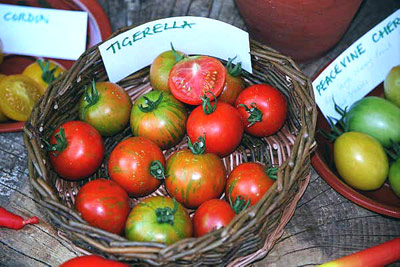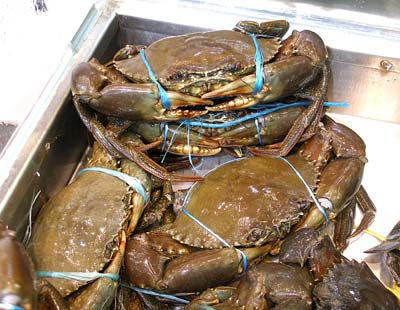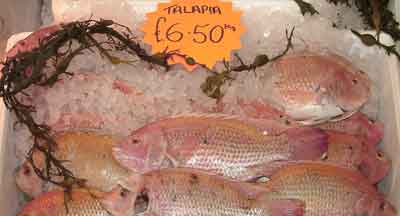Mr Presee is a pink-blush variety of potato from 1845
A blue cow's milk cheese made from pasteurised milk from the same dairy that produces Yorkshire Blue and Olde Yorke.
A variety of runner bean with a red flower and black seeds which is attractive but not the best to eat.

Tigerella. An indeterminate English tomato variety producing 5 cm (2 inch) fruits which are green striped when immature, ripening to red striped with yellow orange. They have a rich, tangy flavour and appear in mid season.
A name for the Moreton Bay bug, a type of sand lobster. Sand lobsters are any of a variety of small crustaceans bearing a resemblance to lobsters. There are many of them, including bay bug, bay lobster, shovel-nosed lobster and rudder-nosed lobster which is similar to a slipper lobster. Moreton Bay bugs and Balmain bugs are available commercially. Moreton Bay bugs are slightly more triangular than the Balmain bug.

The mud crab or mangrove crab is a type of swimming crab found around the northern coasts of tropical Australia and making very good eating. It is found in the muddy bottoms around mangroves in estuaries and shallow bays. Only males are fished, usually using pots. They make very good eating indeed, although we found their musculature completely different from European crabs, with the meat not lifiting from the claws or from the carapace in a single succulent mouthful, but very flaky, requiring a great deal of thorough scraping to get at it. It is definitely worth the trouble as the flesh is remarkably sweet and well-flavoured. The colour of mud crabs will vary, as Denis Christie in Sydney Fish Market told me, depending on whether they have been caught in a sandy or muddy environments, those from mud being darker and greener. They are kept bound up when sold live, as they most frequently are, to prevent injury to other crabs. This crab, like so many others, has in the past been known as the black, brown of green crab, as well as the giant mud crab and, in error, the orange mud crab. When asked if he was going anywhere for his holidays, Stewart, one of the guides at the Bloomfield Lodge in Weary Bay in Northern Queensland replied that he was just going to stay put and fish a few mud crabs. A happy man.

A name in South Africa for tilapia. Mainly found in freshwater lakes and rivers, tilapia may also be found in estuaries and brackish water. They are found in quantities in Lake Victoria and are farmed throughout tropics. Perch-like or bream-like, with a slight muddiness about them.
Mesentery. A frilly membrane in the lining of the abdominal cavity which keeps the intestines in place, often used in sausage making.
A variety of hake: a long, lean member of the cod family. Although they can grow up to 1 meter (3 ft) in length, the average size now is about 30-50 cm (12-30 inches). They are found in temperate and cold waters. During the day they lurk on the bottom, but rise in the evenings to hunt for fish such as herring and mackerel.